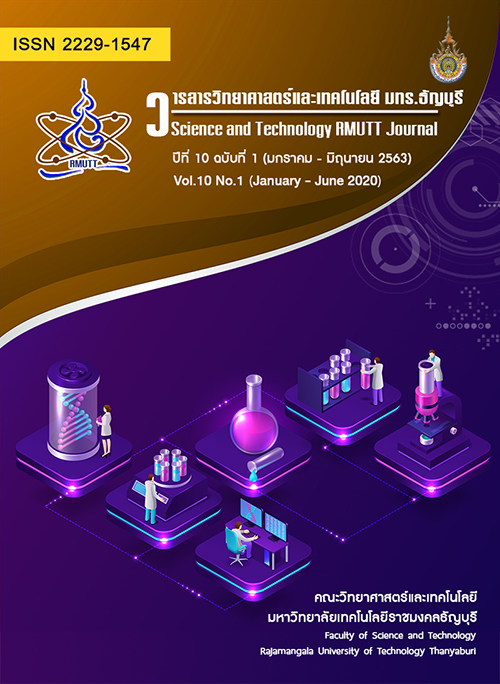Effect of Experimental Activity Package and Mobile Application on Achievements of Upper Secondary Students: Momentum and Collision
Main Article Content
Abstract
The research aimed 1) to compare the learning achievement in the topic on momentum and collision between pre-test and post-test by using experimental activity package and mobile application 2) to compare the learning achievement in the topic on momentum and collision of students who studied using experimental activity package and mobile application and students who were taught regularly. The samples used 80 tenth-grade students in science and mathematics classroom of a large secondary school in Nakhonsawan. We set to classroom in our study. Firstly, the experimental group, 39 students, were taught experimental activity package and mobile application of momentum and collision. The second classroom, the control group, consisted of 41 students who were taught regularly.
The research instrument used in this study consisted of the experimental activity package and the achievement test on the topic of momentum and collision. The statistics for the data analysis included mean, standard deviation and T-test. We found that the experimental group had higher achievement post-test score more than pre-test score which the achievement average of post-test of the experimental group showed higher scores than of the control group with level of statistical significance 0.05. This result can be concluded that the experimental activity package with mobile application can develop the learning achievement in secondary school classrooms.
Article Details
References
ธนกร อรรจนาวัฒน์. การพัฒนาความ สามารถในการสื่อสารวิทยาศาสตร์และการทำงานเป็นทีมโดยใช้การจัดการเรียนรู้แบบแสวงหาความรู้เป็นกลุ่มของนักเรียนชั้นมัธยมศึกษาปีที่ 5. An Online Journal of Education. 2016;11(1) : 201-18.
สถาบันส่งเสริมการสอนวิทยาศาสตร์และเทคโนโลยี. หนังสือเรียน รายวิชาเพิ่มเติม ฟิสิกส์ เล่ม 2 กลุ่มสาระการเรียนรู้วิทยาศาสตร์. พิมพ์ครั้งที่ 2. กรุงเทพฯ: สกสค; 2554.
บุญเกื้อ ควรหาเวช. นวัตกรรมการศึกษา. พิมพ์ครั้งที่ 5. กรุงเทพฯ: ภาควิชาเทคโนโลยีทางการศึกษา คณะศึกษาศาสตร์ มหาวิทยาลัยศรีนครินทรวิโรฒ; 2545.
เรวดี มานุ้ย. การพัฒนาชุดทดลองกลศาสตร์สำหรับนักเรียนชั้นมัธยมศึกษาปีที่ 4 ของโรงเรียนพัทลุง. บัณฑิตวิทยาลัย มหาวิทยาลัย ราชภัฏสงขลา: มหาวิทยาลัยราชภัฏสงขลา; 2556.
นภาพร หงษ์ทอง, เสกสรรค์ ทองคำบรรจง. การวิเคราะห์โมเดลเชิงสาเหตุของพฤติกรรม ติดสมาร์ทโฟนและผลกระทบของนักเรียนระดับมัธยมศึกษา สังกัดสำนักงานเขตพื้นที่การศึกษามัธยมศึกษา เขต 6. วารสารวิชาการ บัณฑิตวิทยาลัยสวนดุสิต. 2562;15(3) : 16.
เอกราช ตาแก้ว, รัศมี ชัยสุขสันต์. การดัดแปลงอุปกรณ์ชุดศึกษาสเปกตรัมเพื่อ การบันทึกด้วยสมาร์ทโฟน. วารสารวิทยาศาสตร์และเทคโนโลยี มหาวิทยาลัยอุบลราชธานี. 2561;20(3) : 90-100.
Serway RA. Principles of physics : a calculus-based text. 5th ed., international ed.. ed. Jewett JW, editor. Australia: Australia : Brooks/Cole, Cengage Learning; 2013.
ชูจิต สาระภาค. ผลการใช้ชุดฝึกปฏิบัติการ ที่มีต่อผลสัมฤทธิ์ทางการเรียนและทักษะการใช้เครื่องมือ การทดลองในวิชาปฏิบัติ การฟิสิกส์ของนักศึกษาสถาบันราชภัฏเชียงใหม่: บัณฑิตวิทยาลัย มหาวิทยาลัย เชียงใหม่; 2547.
คณากรณ์ รัศมีมารีย์. การพัฒนาชุดปฏิบัติการทดลองวิทยาศาสตร์เรื่องสาร และสมบัติของสาร สำหรับนักเรียนชั้นมัธยมศึกษาปีที่ 4 โรงเรียนสาธิตมหาวิทยาลัยศรีนครินทรวิโรฒ ปทุมวัน. วารสารศรีนครินทรวิโรฒวิจัยและพัฒนา (สาขามนุษยศาสตร์ และสังคมศาสตร์). 2559;8(16) : 125-35.
ประนอม หมอกกระโทก. การพัฒนาชุดทดลองเรื่องการเคลื่อนที่ในแนวตรง ในระดับชั้นมัธยมศึกษาตอนปลาย: ปริญญานิพนธ์ (กศ.ม. (วิทยาศาสตรการศึกษา)) มหาวิทยาลัยศรีนครินทรวิโรฒ, 2545.
สุธิตา ประดับ, ทัดดาว เทพทิตย์, และวีรมลล์ ไวลิขิต. เทคนิคทางโฟโตเมทรีด้วยสมาร์ทโฟนสำหรับรายวิชาเคมีระดับปริญญาตรี Journal of Education Naresuan University. 2018;20(2) : 233-40.
เหนือตะวัน ธำรงสิริภาคย์. การวัดอัตราปริมาณรังสีเอกซ์โดยใช้สมาร์ตโฟน. จุฬาลงกรณ์มหาวิทยาลัย คณะวิศวกรรม ศาสตร์: จุฬาลงกรณ์มหาวิทยาลัย; 2558.






